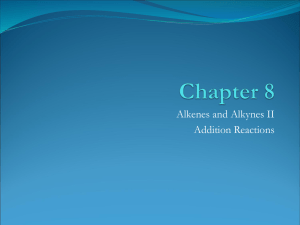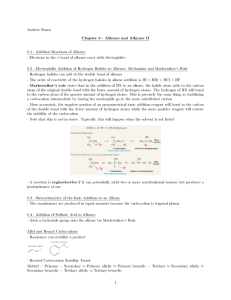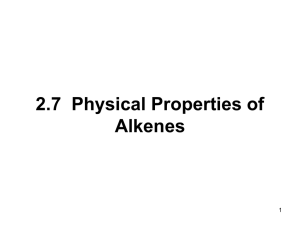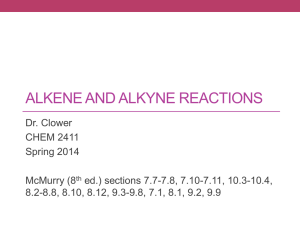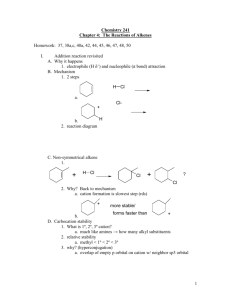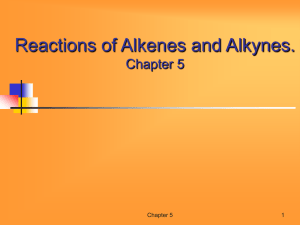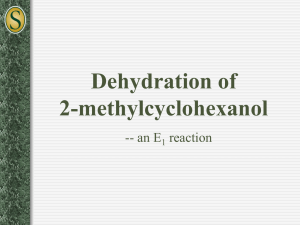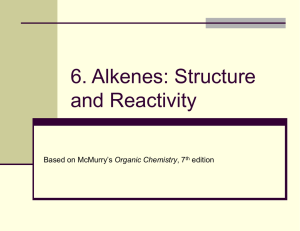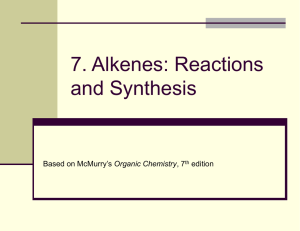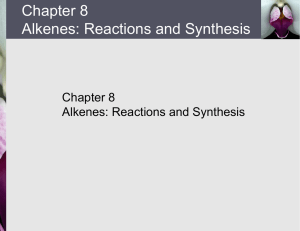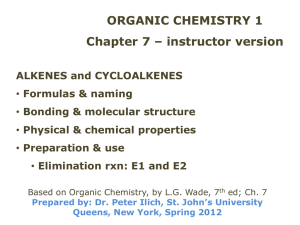Chapter 8
advertisement
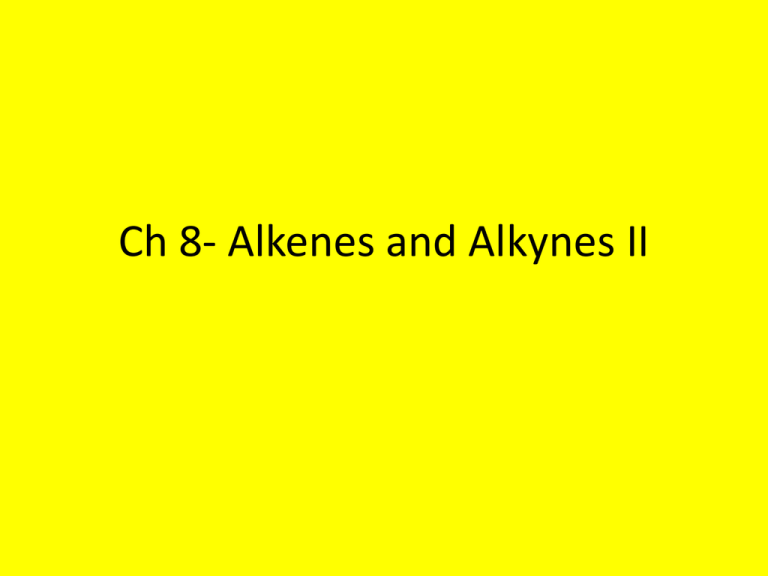
Ch 8- Alkenes and Alkynes II Addition Reactions • A characteristic reaction of compounds with carbon-carbon double and triple bonds is an addition reaction • Generic example: • We have already covered the addition of hydrogen in chapter 7 Two Characteristics • There are two characteristics of double bonds that help explain why these reactions occur: 1) Converting 1 pi bond and 1 sigma bond to 2 new sigma bonds is energetically favorable 2) The electrons of the pi bond are exposed and therefore can react as a nucleophile A. Addition of Hydrogen Halides to Alkenes • Hydrogen Halides- HI, HBr, HCl, HF • Order of Reactivity: HI > HBr > HCl >> HF • Examples: Markovnikov’s Rule • Unsymmetrical alkenes follow Markovnikov’s Rule • Markovnikov’s Rule- in the addition of HX and water to an alkene, the hydrogen atom will add to the carbon of the double bond that already has the greater number of hydrogen atoms • example Markovnikov’s Rule • Markovnikov actually stated that the reaction will proceed through the most stable carbocation intermediate. • Mechanism: • Both versions typically give the same results, however, focusing on the carbocation is always right, whereas the focusing on the hydrogens will only be right about 95% of the time. Markovnikov’s Rule • When an addition follows Markovnikov’s rule, it is said to be a Markovnikov addition • This is an example of a Regioselective reaction • Regioselective Reaction- When a reaction that can potentially yield two or more constitutional isomers actually produces only one, or a preponderance of one. • There are ways to do an Anti-Markovniknov addition, which we will cover later. Stereochemistry of Ionic Additions to an Alkene • When HX is added to an alkene, a stereogenic carbon is possibly formed. • Since the reaction proceeds through an achiral carbocation, the result is a racemic mixture, equal amounts of R and S forms. • This is the same conclusion and reasoning we had with Sn1 reactions. Addition of Hydrogen Halides to Alkynes • Alkynes react with hydrogen chloride and hydrogen bromide to form haloalkenes or geminal dihalides depending on whether one or two molar equivalents of the hydrogen halide is used • Both additions are regioselective and follow Markovnikov’s Rule • examples Addition of Hydrogen Halides to Alkynes • By using acetyl Bromide with alumina, we can selectively form the haloalkene • This is also Markovnikov addition. • If we add HCl or HBr with peroxides present, we can get the anti-markovnikov haloalkene Addition of Sulfuric Acid to Alkenes • The mechanism is the same as adding HX, but we are adding cold H2SO4 • Markovnikov addition • Mech: • The alkyl hydrogen sulfate product can easily hydrolyze to an alcohol by heating with water • Ex. Addition of Sulfuric Acid to Alkenes • The overall result of the addition of Sulfuric Acid to an alkene followed by hydrolysis is Markovnikov addition of water! Addition of Water to Alkenes • Acid Catalyzed Hydration • Mech: • Markovnikov addition • Via carbocation, watch for rearrangements! Addition of Water to Alkenes • Oxymercuration-Demercuration • Advantage: Avoids carbocation and rearrangements • Markovnikov addition Addition of Water to Alkenes • Hydroboration-Oxidation • Advantages: – Avoids Carbocation – Anti-Markovnikov addition – Syn-addition • Ex Addition of Water to Alkenes • Hydroboration-Oxidation, cont. – Hydroboration step can be done with diborane, B2H6, but it is a gas and hard to work with – It is easier to use a Borane/THF complex • Mechanism for Hydroboration: – Concerted step = syn-addition – Borane bonds to least substituted carbon due to steric factors Addition of Water to Alkenes • Hydroboration-Oxidation, cont • Mechanism for Oxidation step: – The oxidation and hydrolysis takes place with retention of configuration at the carbon initially bearing the boron and ultimately bearing the –OH group – In the end, the hydroxyl group ends up in the exact space the boron was in! • Mech: Addition of Water to Alkenes SUMMARY Protonolysis of Alkyl Boranes • Instead of oxidation, a carboxylic acid with heat can be used to protonate the alkyl borane – Happens with retention – Used to label with D or T – The H, D, or T takes exact place of Boron – Example: Addition of Bromine and Chlorine to Alkenes • • • • Reacts to form vicinal dihalides Saw this in ch. 7 Ex. Mech: Stereochemistry of Halogen Addition • Because the Bromonium ion forces opposite side attack, this is anti-addition • Either carbon of the bromonium ion can be attacked which leads to a mix of enantiomers • Addition of halogens can also be stereospecific reaction Stereospecific Reaction • Stereospecific Reaction- when a particular stereoisomeric form of the starting material reacts in such a way that it gives a specific stereoisomeric form of the product. • Stereoselective and stereospecific are different! • Consider cis-2-butene vs trans-2-butene Addition of Bromine and Chlorine to Alkynes • Reacts the same way alkenes do • May react once or twice, depending on the molar equivalents of bromine/chlorine added • Example • It is usually possible to prepare dihaloalkenes by simply adding one molar equivalent of the halogen • Most additions are anti, and give the transdihaloalkene Halohydrin formation • If a halogenation of an alkene is done in water instead of an organic solvent, you do not get a vicinal dihalide • Instead you get a halo alcohol, called a halohydrin • Ex. Halohydrin formation • The mechanism starts like the halogenation but instead of the second halide attacking, water does. • If the alkene is unsymmetrical, the halogen ends up on the carbon with the most hydrogens because the water will attack the most substituted carbon. Oxidation of Alkenes • Syn 1,2-dihydroxylation – Alkenes can undergo a number of reactions in which the carbon-carbon double bond is oxidized – One reaction is with Osmium tetraoxide to produce 1,2-diols (also called glycols) – This is syn-addition • Ex. • Mech. Oxidative Cleavage of Alkenes • Alkenes can be oxidatively cleaved using either Potassium Permanganate or Ozone • Potassium Permanganate is stronger and will result in ketones and carboxylic acid groups • Ozone is milder and will result in ketones and aldehydes Oxidative Cleavage of Alkenes • KMnO4 examples: • O3 examples: Oxidative Cleavage of Alkynes • Treatment of Alkynes with either Ozone or Potassium permanganate will lead to carboxylic acids • examples Synthetic Strategies, Revisited • In planning a synthesis, we consider four interrelated aspects: 1) 2) 3) 4) Construction of the Carbon Skeleton Functional Group interconversions Control of regiochemistry Control of stereochemistry Construction of Carbon Skeleton • This is making carbon-carbon bonds. • We only know two ways: 1) Using cyanide as nucleophile in substitution reaction -Not really useful right now because we don’t know how to do anything with the cyano group 2) Alkylation of an alkynide ion -This is very useful! We can add multiple carbons at one time and we know how to make alkynes as well as reactions of alkynes 2,3, and 4 • Aspects 2, 3, and 4 all have to do with one another • As we convert functional groups into each other, we have to keep in mind regioselectivity and stereoselectivity Example • If we wanted to make an alcohol from an alkene, we know 3 ways: 1) Acid-Catalyzed Hydration -no chance of rearrangement or want rearrangement? -Markovnikov addition 2) Oxymercuration-Demercuration -prevents rearrangements -Markovnikov addition 3) Hydroboration-Oxidation -anti-markovnikov addition Knowing your Functional Group Conversions Is Essential to Synthesis!!!! What we know so far… • (there may be more!!!) • Once you know these conversions, you just take it one step at a time!! Sample Problem • Outline a synthesis of 2-bromobutane from compounds of two carbon atoms or fewer.
